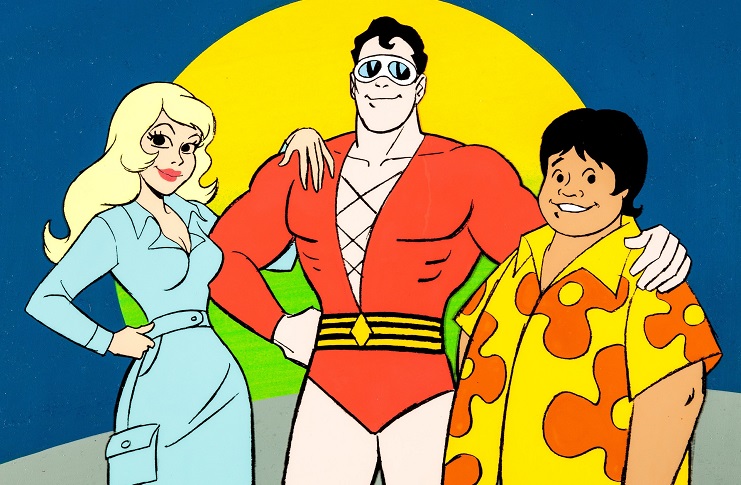
Animators Joe Ruby and Ken Spears created one of the most popular cartoons of all time for Hanna-Barbera, Scooby-Doo. The duo parlayed that into running the Saturday morning lineups for CBS and ABC. In 1977, they decided to start their own animation studio, Ruby-Spears Productions. Last week, I profiled their first project, Fangface. While it aired as a freestanding show in 1978, in its second season, Fangface was shortened (but its name extended) and folded into a longer anthology program The Plastic Man Comedy/Adventure Show, which was headlined by a long-running DC Comics superhero.
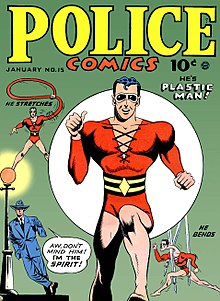
Created by Jack Cole, Plastic Man made his debut in Police Comics #1 in 1941. At first, it was published by Quality Comics which continued to chronicle the character’s exploits until selling its library to DC in 1966.
After being bought by DC, Plastic Man was rarely a headliner, but he was a popular guest star and often appeared in his own strips in anthology comics. His animation debut was in an episode of the first season of Super Friends in 1973. Before that, Hal Seeger Productions and Filmation had plans to animate Plastic Man, but those projects didn’t materialize.
And before we get too far into this, YES, Plastic Man has the worst super suit of all time — red leotard with a plunging V-neck with laces (for some reason), bare legs and feet, and bizarre sunglasses/goggles. It’s a problem that has plagued the character to this day. Even though in the comics and other more recent adaptations his overall look has been tweaked to seem a bit less ridiculous, it’s still not a great suit.
In the original comics, former criminal Patrick “Eel” O’Brian was shot during a burglary and fell into a vat of chemicals. As a result, he discovered he could stretch any part of his body and even shapeshift into any form he could imagine.
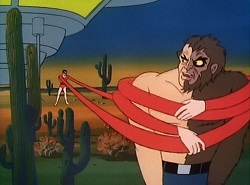
Cole differentiated the Plastic Man strip by injecting a heavy dose of comedy into his adventures. Much of the humor derived from Plas’ bumbling sidekick Woozy Winks. In the originals, Plas was the straight man reacting to the wildness around him. But in modern depictions, Plastic Man is presented as the source of humor — similar to Jim Carrey as The Mask.
The former was the general depiction of the character on The Plastic Man Comedy/Adventure Show. Plas, voiced by the great Michael Bell, was generally a straightforward hero, although he tended to wisecrack, similar to Spider-Man. On his adventures, he was accompanied by his bad luck-plagued Polynesian sidekick Hula Hula (Joe Baker), replacing the Caucasian Woozy Winks from the comics, and the blonde bombshell, Penny (Melendy “She-Ra” Britt). Penny was in love with Plas. However, he only had shaded eyes for The Chief, the female agent that assigned him missions, who was also voiced by Britt.
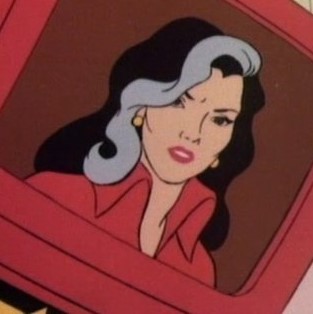
The Plastic Man Comedy/Adventure Show debuted in 1979 on ABC, airing right after another show based on DC Comics characters, Super Friends. It lasted for two seasons.
Among Ruby and Spears’ previous creations for Hanna-Barbera was Dyno-Mutt, Dog Wonder, a superhero parody featuring a Batman-like crusader named Blue Falcon and his inept robotic canine sidekick. In each episode, Blue Falcon and Dyno-Mutt would take on a new colorful supervillain that was slightly more comedic and outlandish than the criminals that appeared in mainstream comics.
The bad guys on Plastic Man very closely followed the model that Ruby and Spears had established on Dyno-Mutt. Three villains — Doctor Dome, Doctor Honctoff, and Carrot-Man — came from the comics, while all others were original Ruby-Spears creations. In the first episode, Plas took on the plant-based rogue, The Weed. (That name!) In the second, he battled an anthropomorphic clam called… well, The Clam. He also thwarted an evil genie named Badladdin and took on another crook named… *ahem* Ghost Finger. Moving on…
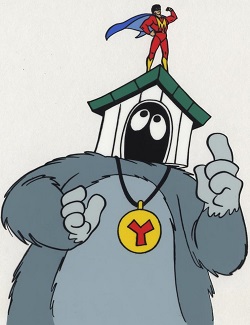
The Plastic Man Comedy/Adventure Show was originally two hours long. The Plastic Man segments lasted for 30 minutes, but the other features were only 15 minutes in length. (Minus commercials, of course.) Those shorts included a truncated Fangface, renamed Fangface and Fangpuss, which introduced the infant cousin of the lead lycanthrope.
Another feature was Mighty Man and Yukk, which starred a tiny super-strong hero (with a gigantic afro) and his dog, Yukk, who was so ugly that he wore a small doghouse on his head to hide his face. In each episode, Yukk would remove his doghouse helmet with his back to the audience. His appearance would either horrify anyone who viewed him or destroy anything he looked at.
Peter “Optimus Prime” Cullen voiced Mighty Man, and Frank Welker voiced Yukk. John Stephenson provided the voice of The Mayor of their unnamed city, who usually assigned them their cases.
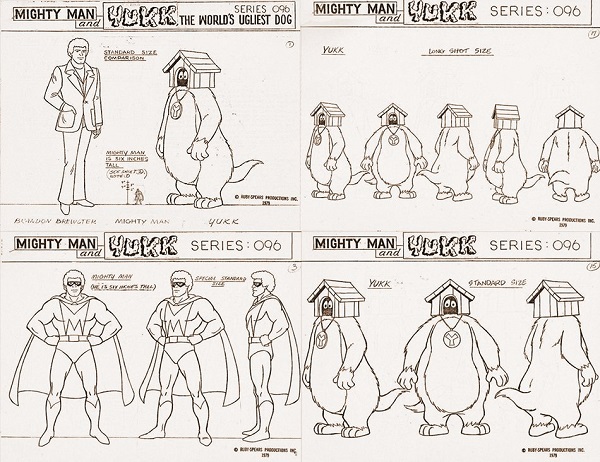
*Sigh* and then there’s Rickety Rocket.
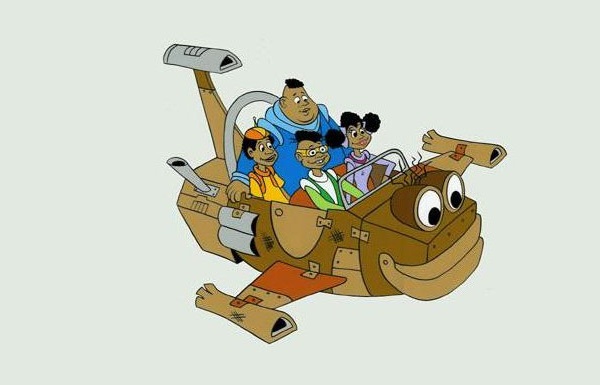
While it was surely meant well, Rickety Rocket hasn’t aged well. The show was set in outer space sometime in the future and followed a quartet of black teenagers — Sunstroke (John Anthony Bailey), Splashdown (Johnny Brown), Cosmo (Bobby F. Ellerbee), and Venus (Dee Timberlake). Together, they flew around in a sentient spaceship called Rickety Rocket (Al Fann), who was like a cross between Speed Buggy and The Archie’s junky jalopy.
While it was admirable to frame a cartoon around black teens in the 1970s, the show fed into certain stereotypes that are considered negative today. For example, the kids were clearly poor. That’s why their spaceship — despite being alive — is a piece of junk. And, I mean, did they have to make Rickety Rocket’s lips so big?
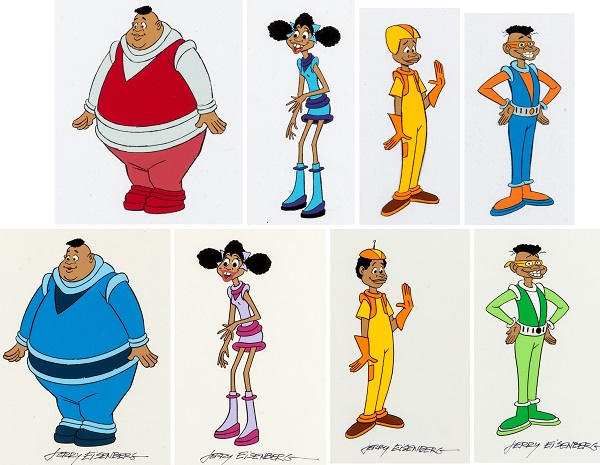
Warner Bros.
For the second season, The Plastic Man Comedy/Adventure Show was shortened from two hours to 90 minutes and a greater emphasis was placed on Plastic Man himself and his family with two new short segments added. The show’s title was changed to The Plastic Man/Baby Plas Super Comedy Show.
It appears that Fangface and Fangpuss and Rickety Rocket were dropped. Since I can’t find intact episodes, I don’t know if that’s 100% correct. There isn’t a ton of solid info about this show online. The new format could have rotated through repeats of the supporting character shorts. There were 32 Mighty Man and Yukk shorts, so there was either an entire second season of these or it was shown twice per episode in Season 1.
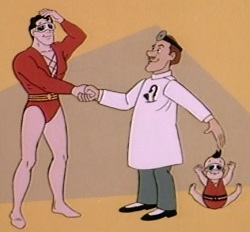
Plas gave up his crush on The Chief and married Penny between the first and second seasons. They had a baby simply called Baby Plas, who inherited his father’s elastic abilities. Frank Welker also voiced Baby Plas. In this picture, Plas is meeting his LITERAL “bouncing baby boy.”
Ruby-Spears had a thing for babies, as this introduction emulated that of Fangpuss on Fangface. This could have been part of a trend to introduce cute child/baby characters in cartoons to broaden their appeal, perhaps to younger kids or girls. Coincidentally (or not) that same year, Scrappy-Doo also debuted on ABC.
A heavy focus was given to Baby Plas. In addition to the regular 30-minute Plastic Man adventure, each episode included a short featuring The Plastic Family, focusing on Plastic Man, Penny, and Baby Plas. There was also a separate Baby Plas short that usually depicted the rubbery tike causing problems for his babysitter, Hula Hula.
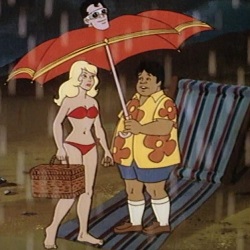
Ultimately, there were 35 30-minute Plastic Man installments, 32 of Might Man and Yukk, and 13 each of Fangface and Fangpuss, Rickety Rocket, The Plastic Family, and Baby Plas.
There is an intro for The Plastic Man Comedy/Adventure Show that touts the inclusion of Plastic Man, Mighty Man and Yukk, Rickety Rocket, Fangface and Fangpuss, as well as Goldie Gold and Action Jack, and three more segments, Heathcliff, Marmaduke, and Dingbat and the Creeps.
You can check that intro out below:
I think this is from the syndicated version of this series. I’m pretty sure Goldie Gold and Action Jack was its own series. And Heathcliff was its own 30-minute cartoon but was aired in tandem with the shows Dingbat and the Creeps in 1980 and Marmaduke in 1981.
All of these are Ruby-Spears productions, so I suppose it would make sense to lump them all together in syndication and alternate between the different segments for each day of the week. Individually, there weren’t enough episodes of each series, including Plastic Man, to create a syndication package that requires 64 half-hour episodes to fill an entire season
Speaking of syndication…

Some may not be old enough to have watched the Plastic Man series when it first aired on Saturday mornings. The show was syndicated in the ’80s, and, in an interesting move, new live-action segments were filmed to frame each episode. Actor/stand-up comedian Taylor Marks portrayed the stretchy hero, and the background was designed to look like the inside of the Plastic Jet, the Plastic Team’s mobile headquarters which the hero piloted in the cartoons.
The live-action Plastic Man seems to be more remembered than the cartoon itself. Below, you can see a news feature with Marks meant to promote the syndication package of The Plastic Man Comedy/Adventure Show. There is even an interview with Marks in his “secret identity.”
That’s a pretty awesome find! The humor is clunky but it’s still pretty cool!
Ruby-Spears Productions was originally a subsidiary of Filmways. That company has been bought and sold a few times. Ownership of the Ruby-Spears library has changed hands as well, but most of its library is now owned by Warner Bros., which also owns Hanna-Barbera. That means that Plastic Man has been released on DVD. Even though the DVDs feature the Plastic Man Comedy/Adventure Show intros, they only contain the 30-minute Plastic Man cartoons and none of the other segments.
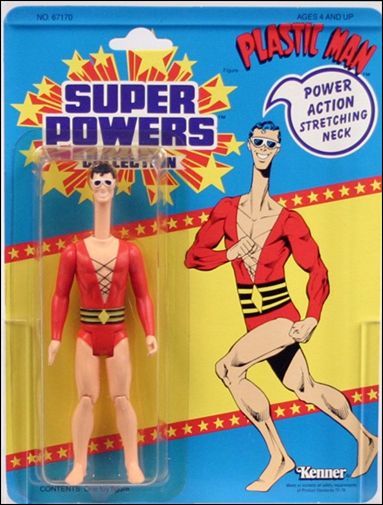
Plas had a higher profile than most DC Comics characters because of his exposure on The Plastic Man Comedy/Adventure Show. Even though his series only aired from 1979-1981, Plastic Man was given an action figure in Kenner’s Super Powers Collection in 1986, along with Shazam, who’d had a live-action show in the 1970s and a cartoon in 1980.
Subsequently, Plastic Man was mentioned as being a member of the Justice League in that cartoon from the early 2000s. Although he didn’t appear onscreen, he still got an action figure in that line. He has appeared in shorts on Cartoon Network’s DC Nation programming block, was a recurring character on Batman: The Brave and the Bold, and has appeared on Young Justice, as well as appearances in other DC animated projects.
Baby Plas was even introduced on The Brave and the Bold. In that version, Plas was married to a red-head named Ramona, and Woozy Winks was tasked with babysitting Baby Plas, instead of Hula Hula. (It is possible that while Warner Bros. owns the Plastic Man Comedy/Adventure Show, it can’t use the original characters? Just a guess.)
With its roster of literally hundreds of superheroes, it’s a little strange that DC’s goofy Plastic Man has had one of the more high-profile runs in mainstream media. Ben Schwartz (Parks and Rec, Sonic the Hedgehog) and Marlon Wayans have both expressed a desire to play the stretchy hero in live-action. However, back in 2020, WB announced plans to make a Plastic Woman movie. Now that WB has been bought by Discovery, it has been heavily reported that the new owner is looking to overhaul its slate of DC projects.
Have you ever seen The Plastic Man Comedy/Adventure Show? Would you like to see Plastic Man in more media?



